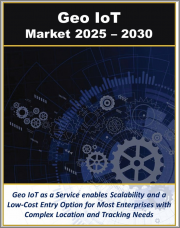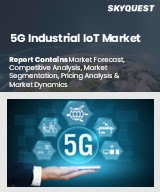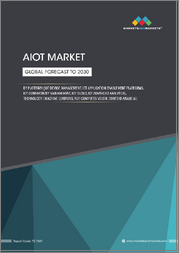
|
시장보고서
상품코드
1692588
Geo IoT 기술, 솔루션, 용도, 서비스(2025-2030년)Geo IoT Technologies, Solutions, Applications and Services 2025 - 2030 |
||||||
사용자 위치를 파악하는 능력은 현대의 개인 커뮤니케이션의 기본 요소로 자리 잡았습니다. 마찬가지로 IoT의 지속적인 성장과 보급을 위해서는 연결된 장비와 자산의 존재를 감지하고 위치를 정확하게 파악하는 능력이 필수적이며, Geo IoT 또는 위치 인식 IoT로 불리는 이 융합은 많은 산업 분야에 혁명을 일으킬 수 있는 잠재력을 가지고 있습니다.
예를 들어 소매업의 경우 위치 정보를 IoT 솔루션에 통합하여 연결성을 강화하고, 비즈니스 프로세스를 간소화하며, 소비자와 기업 모두에게 가치 있는 데이터를 생성할 수 있습니다. 소비자는 개인화된 제안, 실시간 재고 정보, 오프라인 매장에서의 원활한 탐색 등의 혜택을 누릴 수 있습니다. 동시에 소매업체는 고객 행동에 대한 깊은 인사이트, 매장 레이아웃 최적화, 공급망 관리 개선, 자산 추적을 통한 보안 강화 등의 이점을 누릴 수 있습니다.
앞으로 위치 기반 IoT는 전 세계에서 기본적인 요구사항이 될 것입니다. 많은 기존 비즈니스와 달리, 위치 기반 IoT 솔루션 프로바이더는 현재의 지역적 범위를 훨씬 뛰어넘는 견고한 운영 역량을 구축해야 합니다.
이 보고서에서는 IoT와 연계된 프레즌스 기술과 위치정보 및 추적에 대한 지역별 수요를 분석하면서 다양한 산업 및 기업에서의 이용 사례와 용도에 따른 Geo-IoT 시장을 평가했습니다.
위치 기반 IoT에 필요한 하드웨어, 소프트웨어, 서비스의 기술 요구사항과 기술 개발에 대해 조사했으며, 이 부문을 선도하는 기업의 제품, 서비스, 전략적 접근 방식을 분석했습니다. 또한 2025-2030년까지의 상세한 예측을 포함하여 세계 위치 기반 IoT의 사업 기회 전망을 밝히고 있습니다.
주요 조사 결과:
- GPS와 센싱 기술이 중요한 원동력이 될 것으로 전망
- 실시간 위치 추적이 주요 용도로 부상할 전망
- 블루투스 비콘 장비가 가장 큰 시장 점유율을 차지할 것으로 예상
- 세계 Geo IoT 시장은 2030년 1,264억 달러 규모에 달할 것으로 예상
- Geo IoT as a Service는 2030년 114억 달러에 달할 것으로 예상
목차
제1장 개요
제2장 서론
- Geo IoT 인프라
- 위치 정보, 추적, 리포트
- Geo IoT 분류
- 야외 위치 추적
- 실내 위치 추적
- 위치 인식 기술
- 내비게이션
- 물리 자산 추적
- 인간 및 기타 생물의 위치 특정
- IoT와 위치 정보 통합
- Geo IoT as a Service
- 생산성 향상을 위한 Geo IoT
- 상호 운영 가능한 위치 정보 데이터
제3장 Geo IoT 기술 및 용도 분석
- Geo IoT 디바이스 및 컴포넌트
- Bluetooth 비콘 디바이스
- 자산 추적 디바이스
- 스마트 센서
- WiFi 라우터
- 웨어러블 헬스 디바이스
- WiFi RTLS 대응 디바이스
- LoRaWAN 디바이스
- UWB
- RFID 태그
- 소프트웨어 컴포넌트
- 소프트웨어 개발 키트
- 로케이션 API
- 보안 솔루션
- 플랫폼 솔루션
- 위치 데이터 분석
- Geo IoT 기술
- GPS
- Bluetooth Low Energy
- 실시간 위치추적 시스템
- UWB
- LRWAN
- 센서
- 휴대폰 기지국 삼각측량
- Geo IoT 용도
제4장 Geo IoT 기업 분석
- Apple Inc.
- Air-Go
- Bosch.IO GmbH
- Cisco System Inc.
- CloudTags Inc.
- Elecsys Corporation(Lindsay Corporation)
- ESRI
- Estimote Inc.
- Insiteo
- Kontakt.io
- Navisens Inc.
- Inpixon(Nanotron Technologies)
- Skyhook
- TruePosition
- Google Inc.
- IBM Corporation
- Microsoft Corporation
- Qualcomm Technologies
- Wireless Logic
- Ubisense Group
- Pitney Bowes
- HERE Technologies
- Verizon Connect(Telogis)
- TIBCO Software
- Zebra Technologies
- CenTrak(Awarepoint)
- Navigine
- Continental Mapping Company(GISinc)
- Ubiscale
- Sewio Networks
- GeoTraq
- Totalmobile Company(GeoPal)
- Intersec
- Geotab
- Dmti Spatial
제5장 Geo IoT 시장의 분석·예측
- 세계의 Geo IoT 시장 : 2025-2030년
- 세계의 Geo IoT 시장 : 제품·솔루션별
- 세계의 Geo IoT 시장 : 기술별
- 세계의 Geo IoT 시장 : 지역 배포별
- 세계의 Geo IoT 시장 : 용도별
- 세계의 Geo IoT 시장 : 산업별
- 세계의 Geo IoT as a Service 시장 예측
- 세계의 Geo IoT 시장 : 지역별
- 북미 : 국가별
- 유럽 : 국가별
- 아시아태평양 : 국가별
- 라틴아메리카 : 국가별
- 중동 및 아프리카 : 국가별
제6장 결론·제안
- 광고주와 미디어 기업
- AI 프로바이더
- 자동차 회사
- 브로드밴드 인프라 프로바이더
- 통신 서비스 프로바이더
- 컴퓨팅 기업
- 데이터 분석 프로바이더
- 몰입형 기술(AR, VR, MR) 프로바이더
- 네트워크 기기 프로바이더
- 네트워크 보안 프로바이더
- 반도체 기업
- IoT 공급업체·서비스 프로바이더
- 소프트웨어 프로바이더
- 디바이스 제조업체
- 소셜미디어 기업
- 워크플레이스 솔루션 프로바이더
- 기업·정부
- Geo IoT 서비스 프로바이더
수치 :
표 :
KSA 25.04.10Overview:
This report evaluates the market for Geo-IoT in various industrial and enterprise use cases and applications with analysis of regional demand for presence technologies and location determination and tracking in conjunction with IoT.
This report addresses the technology requirements and developments in hardware, software, and services necessary for location enabled IoT. It provides analysis of the products, services and strategic approaches of companies that lead this segment. It also identifies the outlook for location-enabled IoT business opportunities worldwide including detailed forecasts from 2025 through 2030.
Select Report Findings:
- GPS and sensing technology will be the key enabler
- Real-time location tracking will be a key application area
- Bluetooth Beacon device will hold the largest market share
- Global Geo IoT market is poised to reach $126.4 billion by 2030
- Geo IoT as a Service is anticipated to reach $11.4 billion by 2030
The ability to pinpoint a user's location has become a fundamental aspect of modern personal communication. Similarly, the capability to detect the presence and precisely determine the location of connected devices and assets will be crucial for the sustained growth and widespread adoption of the Internet of Things (IoT). This convergence, often referred to as Geo IoT or location-aware IoT, holds the potential to revolutionize numerous industry sectors.
Consider the retail landscape, for instance. Integrating location intelligence into IoT solutions can foster enhanced connectivity, streamline operational processes, and generate valuable data for both consumers and businesses. Shoppers can benefit from personalized offers, real-time inventory information, and seamless navigation within physical stores. Simultaneously, retailers can gain deeper insights into customer behavior, optimize store layouts, improve supply chain management, and enhance security through asset tracking.
A growing number of enterprises are already recognizing the transformative power of embedding location tracking within their IoT deployments. They are leveraging the inherent ability of IoT-integrated technologies to dynamically sense and interpret signals emitted and received from tagged objects or sensors in real time. This capability unlocks a diverse range of solutions and applications catering to both commercial and individual needs.
Prominent examples include the development of smart cities, where location data can optimize traffic flow, manage public utilities, and enhance citizen safety; location-based marketing, enabling highly targeted and contextually relevant advertising; and a multitude of indoor location applications within environments such as retail stores (for customer engagement and inventory management), hospitals (for asset tracking and patient flow optimization), and offices (for space utilization and employee safety).
The increasing prevalence of mobile phones and low-power Bluetooth beacons acting as transceivers is fueling the emergence of innovative application areas within location-enabled IoT. These readily available technologies are particularly driving advancements in location-based services (LBS), offering context-aware information and functionalities to users, as well as sophisticated location-based advertising and marketing strategies that deliver personalized and timely messages based on a user's proximity and behavior.
Looking ahead, location-enabled IoT is poised to become a fundamental global requirement. Unlike many traditional businesses, providers of location-aware IoT solutions will need to establish robust operational capabilities that extend far beyond their current geographical footprint.
This necessity arises from the continuous demand for on-site calibration, maintenance, and upgrades of tracking devices, such as sensors and beacons, ensuring the ongoing accuracy and reliability of these systems across diverse locations worldwide.
Furthermore, the intricacies of indoor location systems often necessitate a collaborative, partnership-driven approach to business operations. The inherent complexities of indoor environments, such as signal interference and the need for granular positioning, make strategic alliances essential. Moreover, the very components of these systems frequently involve assemblies utilizing specialized hardware and software from preferred partners.
These crucial collaborators typically include database providers for storing and managing vast amounts of location data, hardware component suppliers for sensors, beacons, and other devices, software and middleware suppliers for platform development and data processing, and contract service providers for installation, maintenance, and support services. This collaborative ecosystem is vital for delivering comprehensive and effective location-enabled IoT solutions.
Table of Contents
1.0. Executive Summary
2.0. Introduction
- 2.1. Geo IoT Infrastructure
- 2.2. Location, Tracking, and Reporting
- 2.3. Geo IoT Classification
- 2.3.1. Outdoor Location Tracking
- 2.3.2. Indoor Location Tracking
- 2.4. Location Aware Technology
- 2.4.1. Navigation
- 2.4.2. Tracking Physical Assets
- 2.4.3. Locating People and other Living Things
- 2.5. IoT and Location Integration
- 2.6. Geo IoT as a Service
- 2.7. Geo IoT as Productivity Enabler
- 2.8. Interoperable Geolocation Data
3.0. Geo IoT Technology and Application Analysis
- 3.1. Geo IoT Devices and Components
- 3.1.1. Bluetooth Beacon Devices
- 3.1.1.1. Advertising Interval Management
- 3.1.1.2. Broadcasting Power Considerations
- 3.1.2. Asset Tracking Devices
- 3.1.3. Smart Sensors
- 3.1.4. WiFi Routers
- 3.1.5. Wearable Health Devices
- 3.1.6. WiFi RTLS Supported Devices
- 3.1.7. LoRaWAN Devices
- 3.1.8. Ultra-Wide Band
- 3.1.9. RFID Tags
- 3.1.9.1. Passive RFID
- 3.1.9.2. Active RFID
- 3.1.9.3. RFID Readers
- 3.1.1. Bluetooth Beacon Devices
- 3.2. Software Components
- 3.2.1. Software Development Kits
- 3.2.2. Location API
- 3.2.3. Security Solution
- 3.2.4. Platform Solutions
- 3.2.5. Location Data Analytics
- 3.3. Geo IoT Technology
- 3.3.1. Global Positioning System
- 3.3.2. Bluetooth Low Energy
- 3.3.3. Real Time Location Systems
- 3.3.3.1. Trilateration
- 3.3.3.2. RF Fingerprinting
- 3.3.3.3. Time of Arrival
- 3.3.3.4. Proximity Detection
- 3.3.3.5. Triangulation
- 3.3.4. Ultra-Wide Band
- 3.3.5. Long Range Wide Area Networks
- 3.3.6. Sensors
- 3.3.7. Cell Tower Triangulation
- 3.3.7.1. Mobile Phone Tracking
- 3.3.7.1.1. Network Based
- 3.3.7.1.2. Handset based
- 3.3.7.1.3. SIM-based Solutions
- 3.3.7.1.4. Wireless Technologies
- 3.3.7.1. Mobile Phone Tracking
- 3.4. Geo IoT Applications
4.0. Geo IoT Company Analysis
- 4.1. Apple Inc.
- 4.2. Air-Go
- 4.3. Bosch.IO GmbH
- 4.4. Cisco System Inc.
- 4.5. CloudTags Inc.
- 4.6. Elecsys Corporation (Lindsay Corporation)
- 4.7. ESRI
- 4.8. Estimote Inc.
- 4.9. Insiteo
- 4.10. Kontakt.io
- 4.11. Navisens Inc.
- 4.12. Inpixon (Nanotron Technologies)
- 4.13. Skyhook
- 4.14. TruePosition
- 4.15. Google Inc.
- 4.16. IBM Corporation
- 4.17. Microsoft Corporation
- 4.18. Qualcomm Technologies
- 4.19. Wireless Logic
- 4.20. Ubisense Group
- 4.21. Pitney Bowes
- 4.22. HERE Technologies
- 4.23. Verizon Connect (Telogis)
- 4.24. TIBCO Software
- 4.25. Zebra Technologies
- 4.26. CenTrak (Awarepoint)
- 4.27. Navigine
- 4.28. Continental Mapping Company (GISinc)
- 4.29. Ubiscale
- 4.30. Sewio Networks
- 4.31. GeoTraq
- 4.32. Totalmobile Company (GeoPal)
- 4.33. Intersec
- 4.34. Geotab
- 4.35. Dmti Spatial
5.0. Geo IoT Market Analysis and Forecast 2025-2030
- 5.1. Global Geo IoT Market 2025 2030
- 5.2. Global Geo IoT Market by Product and Solution
- 5.2.1.1. Global Geo IoT Market by Hardware Product
- 5.2.1.2. Global Geo IoT Market by Software Product
- 5.2.1.3. Global Geo IoT Market by Service
- 5.2.1.3.1. Global Geo IoT Market by Professional Service
- 5.3. Global Geo IoT Market by Technology
- 5.4. Global Geo IoT Market by Location Deployment
- 5.5. Global Geo IoT Market by Application
- 5.6. Global Geo IoT Market by Industry Vertical
- 5.7. Global Geo IoT as a Service Market 2025-2030
- 5.8. Global Geo IoT Market by Region
- 5.8.1. North America Geo IoT Market by Country
- 5.8.2. Europe Geo IoT Market by Country
- 5.8.3. APAC Geo IoT Market by Country
- 5.8.4. Latin America Geo IoT Market by Country
- 5.8.5. MEA Geo IoT Market by Country
6.0. Conclusions and Recommendations
- 6.1. Advertisers and Media Companies
- 6.2. Artificial Intelligence Providers
- 6.3. Automotive Companies
- 6.4. Broadband Infrastructure Providers
- 6.5. Communication Service Providers
- 6.6. Computing Companies
- 6.7. Data Analytics Providers
- 6.8. Immersive Technology (AR, VR, and MR) Providers
- 6.9. Networking Equipment Providers
- 6.10. Networking Security Providers
- 6.11. Semiconductor Companies
- 6.12. IoT Suppliers and Service Providers
- 6.13. Software Providers
- 6.14. Device Manufacturers
- 6.15. Social Media Companies
- 6.16. Workplace Solution Providers
- 6.17. Enterprises and Governments
- 6.18. Geo IoT Service Providers
Figures:
- Figure 1: Geo IoT Structure
- Figure 2: GPS Enabled Asset Tracking Device
- Figure 3: Smart Sensor Model
- Figure 4: WiFi Sprinkler Controller
- Figure 5: LoRa WAN Device Solution
- Figure 6: RFID Reader Architecture
- Figure 7: Global Geo IoT Market 2025 - 2030
- Figure 8: Global Geo IoT as a Service Market 2025 - 2030
Tables:
- Table 1: Global Geo IoT Market by Product and Solution 2025 - 2030
- Table 2: Global Geo IoT Market by Hardware Product 2025 - 2030
- Table 3: Global Geo IoT Market by Software Product 2025 - 2030
- Table 4: Global Geo IoT Market by Service 2025 - 2030
- Table 5: Global Geo IoT Market by Professional Service 2025 - 2030
- Table 6: Global Geo IoT Market by Technology 2025 - 2030
- Table 7: Global Geo IoT Market by Location Deployment 2025 - 2030
- Table 8: Global Geo IoT Market by Application 2025 - 2030
- Table 9: Global Geo IoT Market by Industry Vertical 2025 - 2030
- Table 10: Global Geo IoT Market by Region 2025 - 2030
- Table 11: North America Geo IoT Market by Country 2025 - 2030
- Table 12: Europe Geo IoT Market by Country 2025 - 2030
- Table 13: APAC Geo IoT Market by Country 2025 - 2030
- Table 14: Latin America Geo IoT Market by Country 2025 - 2030
- Table 15: MEA Geo IoT Market by Country 2025 - 2030



















